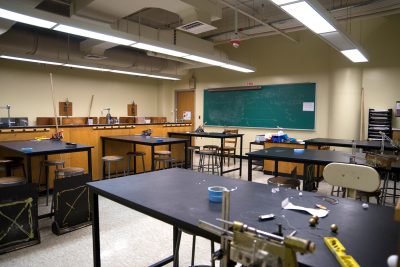
Universities spend more money on STEM courses than on humanities and social science courses, according to a working paper released Monday by the National Bureau of Economic Research.
The paper shows that STEM (science, technology, engineering, mathematics) fields such as electrical engineering, physics and chemistry tend to require greater funding than humanities and social sciences such as English, history and psychology. One notable exception is mathematics, which has the lowest instructional cost of all the fields studied.
Paper co-author Fernando Furquim, a doctoral student at the University of Michigan, said researchers found sizable cost differences across the disciplines they studied, and making these variations known could help higher education practitioners manage budgets.
“Making that picture clearer for practitioners and for policy majors can hopefully help them make more informed decisions or more informed efforts in trying to contain costs if that is something that they need to do,” Furquim said.
Boston University spokesperson Colin Riley wrote in an email that BU has a “deliberate approach to budgeting” and recognizes the necessary cost differences between disciplines. Technology and scientific equipment costs have increased in the last 25 years.
“It is important that the university invest in technologies that students will need to be familiar with in their careers,” he wrote.
BU’s budgeting process allows all departments to identify and meet their financial needs, Riley wrote.
“The strong planning and budgeting process in place at BU ensures all areas have an opportunity to identify and meet their departmental needs,” he wrote.
Some BU students say they have noticed effects due to instruction cost differences between academic fields. Amy Argentar, a sophomore studying environmental analysis and policy in the College of Arts and Sciences, said she has heard that finding mentorship, research opportunities and job offerings is often a struggle for non-STEM students.
“It is always a little frustrating to see all of the opportunities for the earth and environmental science majors and all of their resources while I’m like, ‘What is a social science major to do?’” Argentar said.
Furquim said spending on different disciplines likely varies among different types of institutions, such as public and private. He said universities that emphasize research show larger gaps between disciplines in instructional spending.
The researchers used data provided by the University of Delaware, which Furquim said has been collecting information from a variety of institutions for a long time.
The research was partially spurred by recent university spending on instruction increasing while state support for these institutions decreases, Furquim said.
“Students have had to bear the burden of the cost of education to a much greater degree than in the past, and so we wanted to understand what role disciplinary differences played in that story,” he said. “It’s one thing to note that spending on instruction is potentially going up, it’s another thing to understand how what students are electing to learn affects that number.”
The team also wanted to get an idea of instruction cost differences between disciplines, Furquim said, which education researchers previously had little data on.
Adam Mundy, a junior in the Frederick S. Pardee School of Global Studies, said he thinks the different STEM fields’ higher salaries contribute to STEM courses receiving more funding.
“It would be great to have better resources if social science departments had more funding, but at the end of the day, it makes sense that STEM gets more,” Mundy said. “STEM alumni are more likely to have a higher income and thus be more likely to give more money to STEM departments.”
Kenise Neal, a freshman in the College of Engineering, said she thinks STEM fields should receive more funding, citing the need for developments in areas such as clean water and solar energy.
“I can see how [the instructional cost gap] is unfair to certain people, but it is kind of better because the world is learning more towards engineering,” Neal said. “That’s kind of what we need to progress in the world and to solve all the big problems.”























































































































Erin Propas • Dec 7, 2018 at 12:52 pm
This is true at uvic as well. I noticed, in paying my tuition for this last semester, that my computer science course cost about a hundred dollars more than the rest of my courses. A little strange though because there were no extra materials utilized, our labs were on computers, using free programs. My astronomy course was somehow cheaper but in our first lab we used valuable telescope time; uvic has the largest telescope at any Canadian university. The money though is in computer science, no one becomes rich by looking at the stars!